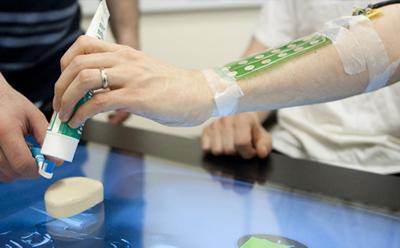Southampton rehabilitation research takes centre stage at Neuro Convention

Staff from the Faculty of Health Sciences are showcasing their expertise at the European Neuro Convention in London this week.
Professor Jane Burridge delivered her key note address about neuro-rehabilitation technologies yesterday and Dr Cheryl Metcalf delivers her keynote on commercialising health technologies this morning.
Dr Metcalf will be talking about her experiences as an entrepreneur and consultant and particularly highlighting a neuro technology in the form a glove which was borne out of research at the University and is now being commercialised by Morgan Innovation & Technology Ltd. She will also be talking about the University spin-out company SHAP, which developed The Southampton Hand Assessment Procedure (SHAP), a clinically validated hand function test. SHAP is now the leading global supplier of an assessment for upper limb prosthetics and an international exporter.
Professor Burridge showcased the M-Mark garment - a new wearable technology that helps people who have had a stroke recover use of their arm and hand.
The garment, which provides automatic, intelligent information about movement and muscle activity while patients practice every-day tasks at home, will be on display.
The convention brings three areas of neurological research – rehabilitation, diagnostics and surgery – together in a two-day event that combines world-leading speakers, seminars, workshops and opportunities to try and test innovative solutions, services and technology.
Professor Burridge said: “About 150,000 people in the UK have a stroke each year and, despite improvements in acute care that results in better survival rates, about 60 per cent of people with moderate to severe strokes fail to recover useful function of their arm and hand.
“Stroke rehabilitation is increasingly home-based, as patients are often discharged from hospital after only a few days. This policy encourages independence and avoids problems associated with prolonged hospital stays. However, some patients struggle to carry out the exercises and are often unsure whether what they are doing is correct. Similarly therapists don’t have objective measurements about their patients’ muscle activity or ability to move. Rehabilitation technologies like M-MARK will address problems faced by both patients and therapists.”
The wearable technology is the first to incorporate mechanomyography (MMG) microphone-like sensors that detect the vibration of a muscle when it contracts, and inertial measurement units (IMU), comprising tri-axial accelerometers, gyroscopes and magnetometers that detect movement. Data from the two types of sensors will be put together and then data that is not needed, for example outside noise, will then be removed from the muscle signal.
The feedback to patients was presented on a user-friendly computer tablet interface as an Avatar giving an accurate representation of their movement. They will get some encouraging feedback and will be able to see how much they have practiced and whether they have improved.
To learn more visit the conference website.